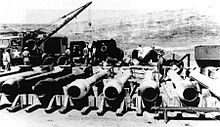Thin Man (nuclear bomb)
| Thin Man | |
|---|---|
Los Alamos Laboratory | |
| Specifications | |
| Length | 17 feet (5.2 m) |
| Diameter | 38 inches (97 cm) |
| Filling | Plutonium |
"Thin Man" was the code name for a proposed plutonium-fueled gun-type nuclear bomb that the United States was developing during the Manhattan Project. Its development was abandoned in 1944 after it was discovered that the spontaneous fission rate of nuclear reactor-bred plutonium was too high for use in a gun-type design due to the high concentration of the isotope plutonium-240.
Early decisions
In 1942, prior to the
Oppenheimer reviewed his options in early 1943, and he gave priority to the gun-type weapon,
Naming

The gun-type and implosion-type designs were code-named "Thin Man" and "
Development

To work on the plutonium gun design, Oppenheimer assembled a team at the Los Alamos Laboratory that included senior engineer
These four created and tested all the elements of the Thin Man design between April 1943 and August 1944. Parsons, who had developed the
Hirschfelder headed the E-8 Interior Ballistics Group. His group performed mathematical calculations, but he also had to identify a suitable
Although the weapon's designers thought that simply bringing a critical mass together would be sufficient, Serber suggested that the design should also include an
Specifications

The "Thin Man" design was an early nuclear weapon design proposed before plutonium had been successfully bred in a
Thin Man was 17 feet (5.2 m) long, with 38-inch (97 cm) wide tail and nose assemblies, and a 23-inch (58 cm) midsection. The length was necessary for the plutonium "bullet" to achieve adequate speed before reaching the "target". Weight was approximately 8,000 pounds (3,600 kg) for the final weapon model.
Although Ramsey had suggested the Lancaster, the chief of the USAAF, Lieutenant General Henry H. Arnold, rejected the suggestion, preferring an American type, specifically the B-29. Prior to dropping trials of the Thin Man and Fat Man dummy bombs, Brigadier General Leslie Groves, the director of the Manhattan Project, suggested the use of the Lancaster for trials since the B-29, although in production, was still scarce.[17] Again, Arnold rejected the suggestion, as he had invested much time and money in the B-29's development.[18]
Design issues
Aerodynamics

The great length of the Thin Man bomb led to aerodynamic instabilities. Subscale models of the bomb were dropped from a
Predetonation
The feasibility of a plutonium bomb had been questioned in 1942.
In April 1944, experiments by
The impracticability of a gun-type bomb using plutonium was agreed at a meeting held on 17 July 1944. All gun-type work in the Manhattan Project was directed at the Little Boy enriched uranium gun design, and almost all of the research at the Los Alamos Laboratory was re-oriented around the problems of implosion for the Fat Man bomb.[25][26]
Notes
- ^ Hoddeson et al. 1993, pp. 42–44.
- ^ a b Hoddeson et al. 1993, p. 55.
- ^ Hoddeson et al. 1993, p. 87.
- ^ Serber & Crease 1998, p. 104.
- ^ Bowen 1959, p. 96.
- ^ Rhodes 1986, p. 481.
- ^ Hoddeson et al. 1993, pp. 83–84.
- ^ Hoddeson et al. 1993, pp. 83–84, 111–112.
- ^ a b c Hoddeson et al. 1993, pp. 126–128.
- ^ Hoddeson et al. 1993, pp. 112–114.
- ^ a b Hansen 1995, p. 106.
- ^ Hoddeson et al. 1993, pp. 119–123.
- ^ a b Campbell 2005, pp. 76–77.
- ^ Rhodes 1986, p. 478.
- ^ Hansen 1995, pp. 107, 119.
- ^ Newman 2020, p. 52.
- ^ Rhodes 1986, p. 479-480.
- ^ McKinstry 2009, p. 495.
- ^ Campbell 2005, p. 42.
- ^ Hoddeson et al. 1993, p. 380.
- ^ Campbell 2005, pp. 8–10.
- ^ Nichols 1987, p. 64.
- ^ Nichols 1987, pp. 64–65.
- ^ Hoddeson et al. 1993, p. 228.
- ^ a b Hoddeson et al. 1993, pp. 240–244.
- ^ Nichols 1987, pp. 138–139.
References
- Bowen, Lee (1959). Vol. I, Project Silverplate 1943–1946 (PDF). The History of Air Force Participation in the Atomic Energy Program, 1943–1953. Washington, D.C.: U.S. Air Force, Air University Historical Liaison Office. Archived from the original (PDF) on 22 February 2014. Retrieved 28 July 2013.
- Campbell, Richard H. (2005). The Silverplate Bombers: A History and Registry of the Enola Gay and Other B-29s Configured to Carry Atomic Bombs. Jefferson, North Carolina: McFarland & Company. OCLC 58554961.
- OCLC 231585284.
- OCLC 26764320.
- McKinstry, Leo (2009). Lancaster: The Second World War's Greatest Bomber. London: John Murray. OCLC 520736950.
- Newman, Grant (August 2020). "Mission Improbable". Aeroplane Monthly. No. 568. pp. 50–59. ISSN 0143-7240.
- OCLC 15223648.
